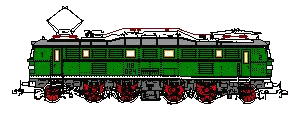
PICTURES OF ROCO and FLEISCHMANN LOKS ON MY LAYOUT
Click on any small picture to see large pictures of the engine. Click on any large picture to return to this screen.
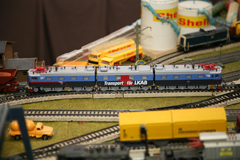
P
ictures of the Roco (69755) LKAB DM3 Series 900 loks. The road numbers for these loks are 1223-1224-1225. The triple electric loks are used by LKAB. Originally the middle lok was called the DM3 with leading and trailing loks simply DM's. Eventually the triple consist was called the DM3. The loks have a light and dark blue livery. The loks is equipped with a front and rear snow plow since it frequently operates within the Arctic Circle connecting the mines of Kiruna and Gällivare and the seaports of Luleå on the Baltic Sea and Narvik on the North Atlantic.The loks have sound. They are smooth running but sometimes they have a problem with M track turnouts.

P
ictures of the Roco (69203) Steam Locomotive 18 201 In Elegance Design. On the occasion of the official re-inauguration on April 30th 2002 in Nürnberg; "damp plus GmbH" and ROCO presented the 18 201 in an new red livery. The design gave this star of the rails a sensational appearance and became part of the 18 201 legend. The festive livery was only worn in 2002. After that the locomotive was returned to her "classic" green livery.The pictures show the "elegant" 18 201 and the "classic" 18 201 on my layout.
Besides the livery difference, the "elegant" 18 201 has a Lok Sound decoder which produces fantastic sounds including boiler sounds. It has squealing brakes as the lok decelerates. I intend to have a similar Lok Sound decoder installed in the "classic" 18 201.
P
ictures of the Roco (69756) MTAB DM3 Series 900 loks. The road number for this lok is 974. The triple electric loks were used by MTAB later taken over by LKAB. Originally the middle lok was called the DM3 with leading and trailing loks simply DM's. Eventually the triple consist was called the DM3. The loks is equipped with a front and rear snow plow since it frequently operates within the Arctic Circle connecting the mines of Kiruna and Gällivare and the seaports of Luleå on the Baltic Sea and Narvik on the North Atlantic.P
ictures of the Roco (69752) Swedish Luossavaara Kiirunavaara Aktiebolag (LKAB) IORE 105-106 double electric lok. The lok is equipped with a front and rear snow plow since it frequently operates within the Arctic Circle connecting the mines of Kiruna and Gällivare and the seaports of Luleå on the Baltic Sea and Narvik on the North Atlantic. IORE stands for the English term, iron ore. The loks have four three-axle drive boogies.Parts for the loks were built in several locations and in several countries but were assembled by Adtranz at its Kassel factory, before they are shipped to Sweden. The IORE 105-106 were build in addition to 101-105. These loks are considered the most powerful electric loks in the world with a maximum pulling force of 10.8 MW or 14,000 HP. They weigh 360 tons including 60 tons of ballast. Maximum speed is 80 km/hr or 48 mph. The loks can haul loads of 8,160 tons up grades of 1.1%. There are twleve axles and each boogie is 7 meters long and 2 meters high with a wheel diameter of 1.25 meters.
The loks are seen pulling a consist of iron ore cars.
The Roco loks are digital with a special Lok Sound decoder for the LKAB double loks with their actual electric lok sounds. The LokSound chip is synchronized to the speed of the engine. There is an air compressor sound and two whistle sounds as well. The Roco loks have no problem pulling this heavy consist up a 4% grade with no reduction in speed. Roco did a great job on these loks. For those of you not familar with the Roco LokSound chips, the decoder number and the many functions can be set with a 6021 with no need to remove the shell. The decoder chip can be set in DCC or the new Motorola mode
.
P
ictures of the Roco (69750) Swedish Luossavaara Kiirunavaara Aktiebolag (LKAB) IORE 101-102 double electric lok. The lok is equipped with a front and rear snow plow since it frequently operates within the Arctic Circle connecting the mines of Kiruna and Gällivare and the seaports of Luleå on the Baltic Sea and Narvik on the North Atlantic. IORE stands for the English term, iron ore. The loks have four three-axle drive boogies.Parts for the loks were built in several locations and in several countries but were assembled by Adtranz at its Kassel factory, before they are shipped to Sweden. The IORE 101-102 are the only loks built so far but more will be built in the future with numbers reserved through 108-109. The combined 101-102 loks cost $4.2 million USD or 8.42 million DM. These loks are considered the most powerful electric loks in the world with a maximum pulling force of 10.8 MW or 14,000 HP. They weigh 360 tons including 60 tons of ballast. Maximum speed is 80 km/hr or 48 mph. The loks can haul loads of 8,160 tons up grades of 1.1%. There are twleve axles and each boogie is 7 meters long and 2 meters high with a wheel diameter of 1.25 meters.
I have used the scenario that Adtranz is testing these loks before shipping them to Sweden. In my scenario Adtranz was asked to move some empty cars, including slag cars, carbide cars, and torpedo cars, back to several foundries or ore processing plants and to return the Belgian SiTrans ore cars to Aschen where they will be picked up by the SNCB/NMBS. My consist is certainly not a normal consist nor would it typcially be pulled by LKAB loks.
The loks are pulling a consist of the Marklin torpedo car (Marklin 48290), a Marklin carbide cylinder car set Marklin (48250), a Trix carbide cylinder set (Trix 23982), a Marklin iron ore car set (Marklin 48448), a Marklin European Coal and Steel Community car set (Marklin 46140) with two slag and two molten iron cars, and two single Marklin molten iron/slag transport cars (Marklin 4478 & 4479). The loks and all the cars have no problem on my M track. I was especially concerned about the torpedo car but I have had no problems with it.
My layout is by no means a proto-typical layout so some consists are not correct.
Kurt Miska points out that some of my consists in this section are both incorrect and, in real life, would be dangerous. "The consist with torpedo cars is really far removed from what would be encountered in a real steel mill. The combination of liquid iron at 1600o C and the carbide cars is extremely lethal. Movement of torpedo cars when filled is restricted and must adhere to a very, very rigid schedule. Further, a consist might have of a diesel or electric Lok, an idler car, a torpedo car, another idler, another torpedo car, another idler and so on for total of probably no more than 3 or 4 torpedo cars. All of this in the interest of safety. The transport of molten slag in the open cars shown at Oberhausen is also not taken lightly. Molten slag might not be a valuable commercial product, it is, by any measure, as dangerous as molten iron."
Actually, I had all of these sets but was looking for the right lok(s) to haul them and the LKAB seemed to be a great choice. The Roco loks are digital with a special Lok Sound decoder for the LKAB double loks with their actual electric lok sounds. The LokSound chip is synchronized to the speed of the engine. There is an air compressor sound and two whistle sounds as well. The Roco loks have no problem pulling this heavy consist up a 4% grade with no reduction in speed. Roco did a great job on these loks.
For those of you not familar with the Roco LokSound chips, the decoder number and the many functions can be set with a 6021 with no need to remove the shell. The decoder chip can be set in DCC or the new Motorola mode.
P![]() Revised:
Revised:
P![]() Revised:
Revised:
To see the history of the TEE click on the image below:
P
ictures of the Roco (69370) Royal Bravarian State Railroad dampflokomotive Class S 3/6. This is a special edition lok which comes with a LokSound chip installed. The lok sounds include synchronized chuffing, a whistle, air and steam release sounds, and coal being shoveled into the firebox. These sounds are turned on with the F 1-4 function keys on the 6021 or the IB which I use.
This lok has a special color scheme in honor of King Ludwig II. It is maintained in the Bavarian Railroad Museum in Nördlingen. It has been used since June 2000 to bring excursions to the Neuschwanstein Theatre where the musical production "Ludwig II - A Yearning for Paradise" is performed.
This model has great detail, has great load power, and the acceleration/deceleration is really good. These are set using a Märklin 6021. There are about 8 different setting that you can make for the lok's performance characteristics.
The pictures show the S 3/6 pulling a consist of K.Bay.Sts.B passenger coaches including a CCü 3rd Class coach, a ABCCü 1st/2nd Class coach and a PPü baggage car. In the last several pictures the engine is seen pulling a consist of cars that were available only to people who were on a special excursion train which travelled to the Neuschwanstein Theater production.
Even though its wheels have Roco flanges it runs well on Märklin metal track. It is a beautiful engine to see, hear, and run.
P
ictures of the Roco Museum (43848) ÖBB dampflokomotive Class 310.23. This is a special edition lok which comes with a Motorola type chip installed. The lok comes in a special "Museum" wooden box with a booklet describing the lok and the efforts of Roco to restore original engine. The lok is now restored and has been used for special excursions.
This model has great detail, is driven from a motor in the tender using a drive shaft from tender to engine and is set by pulses from a 6021 without setting dip switches. You can set acceleration/deceleration and braking in the same way.
The pictures show the 310 pulling a consist of ÖBB passenger coaches.
Because of the low profile flanges used for the lok it does not run as well on Märklin metal track as it does on C track. Nonetheless, it is a beautiful engine to see and run.
P
ictures of the Roco (69880) BLS Ae 8/8, a powerful double Ae 4/4 electric engine. It was used for both passenger and freight traffic over Bern-Lötchberg-Simplon (BLS) routes. In 1950, BLS sought a more powerful engine than its Ae 6/8. The final design was to double two Ae 4/4's providing an output of 8,800 HP and a speed of 125 km/h.P
ictures of the Roco (69201) DB-AG 18 201 high speed steam engine. The wheel arrangement is 2'C1'h3. It was created from two locomotives, the Henschel high speed lok 61 002 and the high pressure H 45 024 lok. This model has a unique design with tractive power on two tender axles and a drive shaft from the tender to the engine which drives three lok drive wheels. The motor is in the tender with a Märklin compatible decoder. This engine, with all it fine detail, makes a great engine for any layout. It can take a #10 Seuthe smoke generator which I have installed.P
ictures of the Roco Museum Edition (43844) of the Bern-Lötchberg-Simplon (BLS) Ae 6/8. This lok has a Roco 10739 Märklin 6090 compatible decoder. The 205 is the last of the BLS Ae 6/8's and has a streamlined look. It is still in service. Roco celebrated this engine by making it a Museum Edition. After the Swiss Crocodile it is perhaps one of the best know engines in Switzerland. It is pictured pulling a consist of four Roco Exclusive (44868) 3rd Class BLS express coaches. Note that the name of the railway is spelled out rather than abbreviated on both the lok and the coaches.
P
ictures of the Roco (43952) AC Märklin compatible BLS Ae 6/8 #206 with a Roco 10739 decoder installed. The lok is pulling a consist of passenger cars. The engine with its fine detail and excellent pulling power is a great addition to the layout.P
ictures of the Roco (69771) 1999 edition of the SBB Ae 8/14 Landi-Lok. This lok is one of the most powerful loks on my layout and in the late 1930's was considered the most powerful engines in the world with 11,100 HP. This version is the 1962 reconstructed lok in the light green livery. The prototype was used for hauling freight and passenger consists on the Gotthard route. It was the third engine of this type built and was unveiled at the 1939 Swiss State Fair in Zurich, (Landesaustellung, state fair), - hence this third engine was called the "Landi"-Lok. This Roco AC version of the lok has a Märklin 6090 compatible decoder with two motors.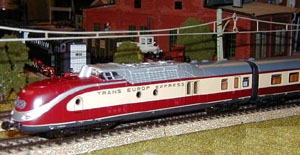
 P
P
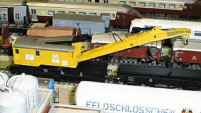
S
everal views of the Roco digital crane. The crane is controlled by both the Intellibox and by the Märklin Control 6021 which allows one to rotate the boom, raise and lower it, raise and lower the hook or a magnet, and turn on either a flood light or the magnet in the crane. A great digital accessory.Click here to go to the Märklin Goliath Crane Car.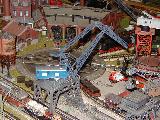
S
everal pictures of the Roco 40111 AC Märklin compatible gantry crane with excavator shovel. The cab swivels and the boom can retract. The hook goes up and down and an the excavator shovel or the magnet attached to the hook can be turned on and off for actual, realistic loading. A great accessory for any layout.
S
everal pictures of a DB ET 420 "Flughafen München" from Roco with a Roco 10739 decoder which is equal to a Märklin 6090 decoder. A very beautiful rapid transit multiple-unit train. These are currently used to go from the München Flughafen (airport) to the city of München and surrounding villages. Very finely detailed with advertisements. Several of the scenes give a good view of the city section of the layout.
S
everal pictures of a DB CARGO Class 145 electric loc. This is a Roco lok with a Roco decoder which is equal to a Märklin 6090 decoder. The freight cars are Märklin cars.